Abstract
A combination of Mind Genomics to understand motivation coupled with Idea Coach (artificial intelligence module within Mind Genomics) was used to create synthetic mind-sets which might describe young males illegally crossing the US southern border. The paper shows how AI can provide information to spur critical thinking when provided with a description of the situation and the motivation for the illegal crossing. The authors suggest that the world of law enforcement might benefit by using these procedures to facilitate critical thinking.
Introduction
As of this writing, February 2024, the United States is experiencing a never-before-situation at its borders. The southern borders of the United States, especially those in Texas, are being inundated by migrants, many of whom are young, unaccompanied men, who slip into the United and end up disappearing inside the United States. Many of these people disappear entirely. Others go to court and are allowed to say pending their case.
Up to now, the material just presented recognizes a problem emerging, namely the escape of many unregistered aliens through what has turned out to be an exceptionally porous border, manned by seriously understaffed border patrols and immigration officers. The consequence is not unexpected. Many people believe that through such unmonitored immigration, there is a good chance an at alien army my be coming in, this army not necessary friends o the United States, the company into which they are disappearing.
The objective of this paper is to demonstrate how AI can be used to formulate hypotheses about the nature of what might be happening at the southern border, and then to demonstrate the change in AI-based ‘conclusions’ when the motive for the invasion includes intending to harm the United States.
History of the Approach
The tool used here is Idea Coach, an AI-empowered program embedded in the Mind Genomics platform [1]. In turn, Mind Genomics is a platform which specializes in the analysis of human judgments, doing so by presenting the respondent (survey taker) with a variety of vignettes, and for each vignette, obtaining a rating on defined scale. The vignettes themselves are combinations of simple, easy-to-read statements, called elements. The vignettes are constructed according to a plan known as an experimental design. Each respondent evaluates a unique set of 24 vignettes [2]. The ratings are then transformed to a simple Yes/No scale. The final steps are to use simple OLS (ordinary least-squares) regression at the level of each respondent to relate the presence/absence of the elements to the transformed ratings. The coefficients of the equations become the tool to understand the mind of the respondent. This simple analysis shows immediately what elements ‘drive’ the ratings, and by so doing reveal the underlying mind of the respondent with regard to the specific topic. The final analysis clusters the respondents into different groups based upon similar patterns of coefficients.
The foregoing approach has been embedded into the aforementioned Mind Genomics platform (www.bimileap.com). The original format of Mind Genomics required that the user provide a set of four questions ‘which tell a story’, and then ‘four answers to each question.’ It was the answers which the respondent evaluated, after these answers (now called elements) were mixed and matched to create the vignette.
AI was necessary to help the user think of questions and answers. Over the period of several years, it became increasingly obvious that users of Mind Genomics both liked the approach but were terrified of the requirement to come up with questions and answers. Figure 1 shows the request to provide four questions. This request was a wall to many prospective users because, quite simply, it was daunting. People were often good at answering questions but not at formulating questions to tell a story.
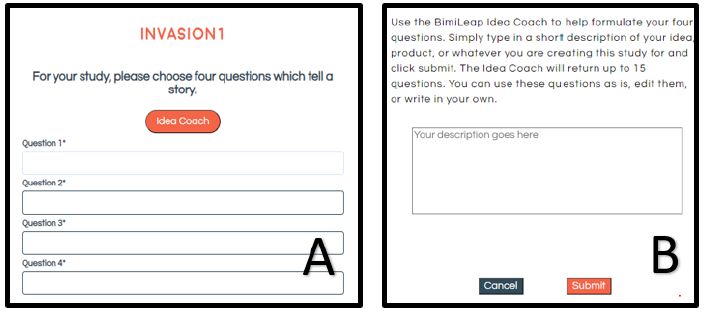
Figure 1: The set-up screen for Mind Genomics studies. Panel A requires the user to provide four questions which tell a story. Panel B shows the Idea Coach, giving the user the opportunity to describe the topic, and turn receive 15 questions generated by AI.
The incorporation of AI into the process of questions and answers increased the acceptance of the Mind Genomics platform, for at least four reasons:
- The process no longer stymied the user. A simple ‘squib’ in Figure 1, Panel B, sufficed to generate 15 questions.
- The same process occurred in the generation of elements. Once the user selected four questions and put those questions into the template (Figure 1, Panel A), the Idea Coach was able to return 15 answers to each question selected.
- The process was rapid, with the suggested sets of 15 questions or 15 answers to a question returning in about 20 seconds.
- The user could edit the squib to change the nature of the questions, or edit the selected questions to change the nature of the answers
The incorporation of AI as Idea Coach ended up producing Idea Books, compilations of questions produced in response to the squib (Figure 1, Panel B), as well as compilations of answers produced in response to each question. Each page in the Idea Book corresponded to one iteration, whether the 15 suggested questions resulting from a request written out in the squib, or 15 answers resulting from the selection of a question. It was not unusual to generate Idea Books of 10+ tabs.
In addition to the sets of questions or answers on each page, the AI was given the task of summarizing the material on each page, viz., the questions or answers. The result was other insights, such as key ideas, themes, perspective, what is missing, interested audiences, opposing audiences, and innovations. Each of the foregoing was given its own section on the page in bold type, and then the relevant AI summarization provided.
The foregoing process required about 30 minutes in total from beginning the set up of the Mind Genomics experiment to the creation of a book with say 20 pages. The process itself was quick, the results were easy to obtain, and the iterations themselves became a source of learning, the Idea Book turning into a resource book for further work.
Over time, and as the process became easier, the process first became rigid as practitioners using Mind Genomics followed the path laid out, with simple questions posed to the AI embedded in Idea Coach. The only modifications during the early days of Idea Coach, the year 2022-2023, was the expansions of the question, so that the questions would have a certain number of word (~ 10-15), that the questions would be interesting, and that the questions could be understood by a young person. The same ‘editing’ of requests was done for the questions themselves in order to generate answers which ‘were not lists, but rather statements which could lead to a discussion’. All of these were style questions, rather than substance questions. The happy consequence was that the Idea Book was richer in content, the questions and answers more instructive, and the process enjoyable to the user, who could practice writing different requests about the style and structure of the output to be generated by Idea Coach
Advancing Insights through Deeper Interactions with AI through the Idea Coach
During the course of working with Idea Coach, author Mulvey expanded the nature of the squib, and generated unexpected and deeper results. Rather than simply specifying the nature of the question or answer in terms of style (viz., number of words, age of reader, style to engage the reader rather than list options), Mulvey added a request into the squib. That request was to provide some additional answers to the question. That is, the squib or input to the AI embedded in Idea Coach contained a request for additional structure in the question, rather than just a question alone. The approach is conceptually similar to the creation of synthetic data, in this case synthetic mind-sets [3].
Idea Coach returned with unexpectedly deeper questions. The output to this ‘expanded request’ was more like a summary of a situation than simply suggested questions. Exploration of alternative ways to expanded the input to Idea Coach quickly revealed that the AI could be requested to a far deeper analysis. And so, the approach was born which lies at the foundation of this paper.
The paper itself explores how the Idea Coach provides more information when given a detailed instruction. Table 1 shows the text as it appears in the Idea Book returned to the respondent. The top section in bold shows what the user types into the squib. The rest of the table shows what it returned to the user by Idea Coach when the Idea Book is completed.
Table 1: Output from Idea Coach for the first request, where the hostile goals of the border crossing men are not revealed.

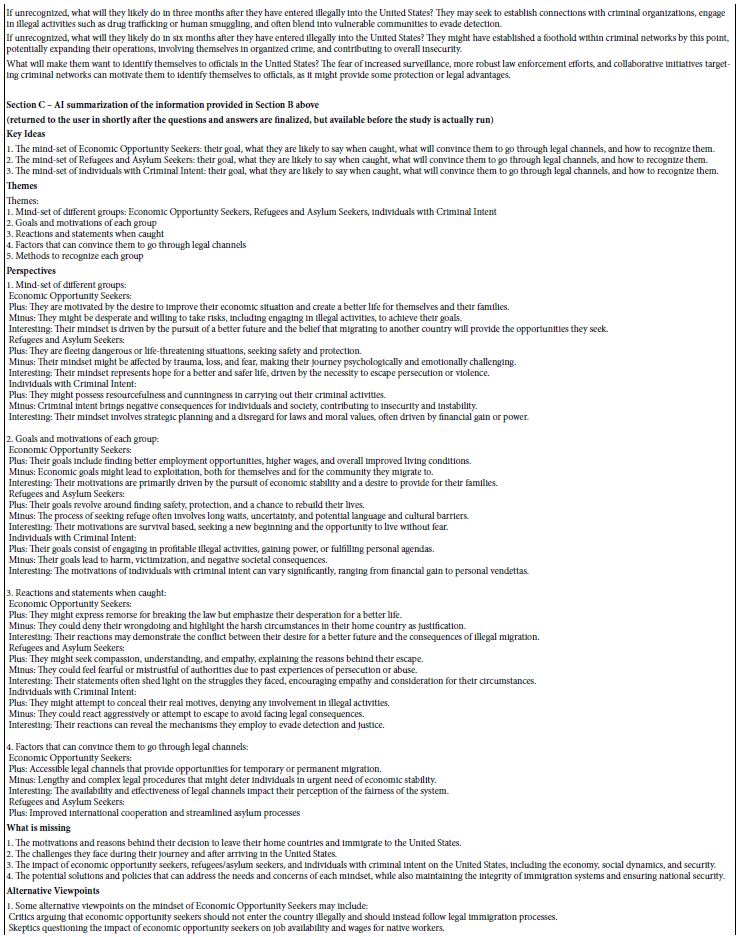
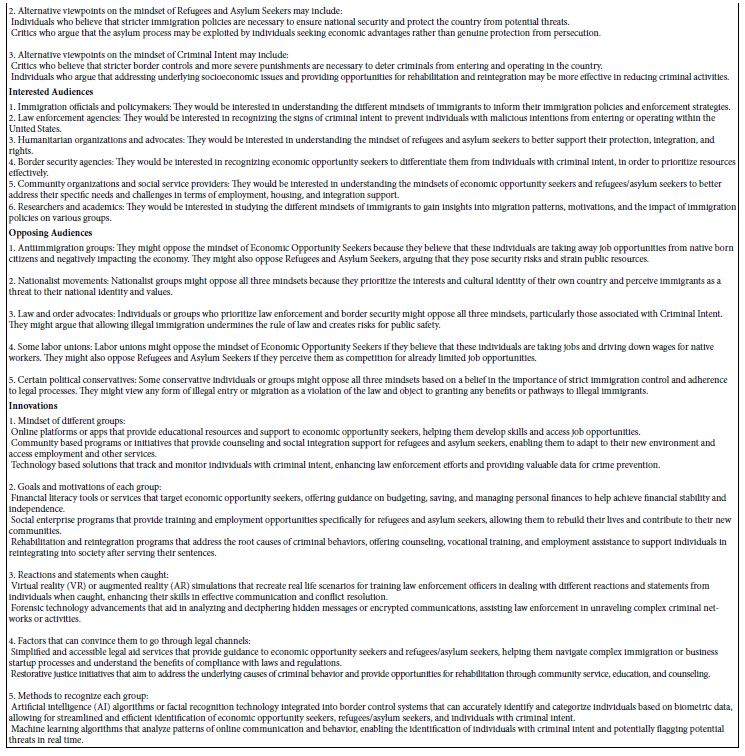
The first part of the input to Idea Coach is simple and direct, describing what is happening., and a simple request for suggestions: The topic is: Invasion of the United States at the southern border cross by unmarried young men of military age. How can we prevent these people from starting massacres at unarmed gatherings throughout the United States if they are truly ‘invading us’.
The second part of the input to Idea Coach is the set-up hypothesis that there exist three mind-sets. These mind-sets are not named, and indeed no information is given about any conjectures regarding the mind-sets. It will be the job of the AI in Idea Coach to suggest the mind-sets. We will see that the suggested mind-sets returned by AI ends up concurring with additional information provided by the user. The actual text is straightforward: We believe that there are three different mind-sets of these young men. The user can change the number of mind-sets and add more information about the mind-sets. Each change generates a new set of responses, further serving as an educational and preparedness tool for the user. and can be modified by the user to see what happens when the number of mind-sets is changed.
The third part of the input to Idea Coach is the instruction to answer a set of eight specific questions for each to-be-named mind-set:
For each mind-set in turn, answer these specific questions:
- What is the name of the mind-set
- What is the goal of the mind-set specifically with regard to being in the United States
- What are they likely to say to an immigration official when they are caught
- What will convince them to go through legal channels to become regular citizens
- How can we recognize them… give four indications to help recognize the mind set to which they belong
- If unrecognized, what will they likely do in three months after they have entered illegally into the United States
- If unrecognized, what will they likely do in six months after they have entered illegally into the United States
- What will make them want to identify themselves to officials in the United States
Do the above answers for each mind-set separately, answering all questions 1-8 for each mind-set in turn
The fourth and final instruction to Idea Coach focuses on the style of the suggestion to be given by Idea Coach:
Make the answers interesting to read, and easy to talk about to other people
Make the answers as realistic as possible
Recognize that the answers will be shared with officials in the United States
Section B in Table 1 shows the immediate work-product of the AI embedded in Idea Coach. Section B returns with 30 seconds. Generally, but not always, Idea Coach provides precise sets of answers, following the instructions written in the squib. The user is free to re-run the Idea Coach many times, changing the squib desired. (That change will be shown in Table 2, where the input to Idea Coach will add information about the migrants ‘wanting to harm America’.) Each iteration of Idea Coach generates a mix of new ideas and old ideas
Section C in Table 1 shows a set of summaries created by AI, with these summaries taking into account all of the information in Sections A and B, respectively. The summarizing queries in Idea Coach are fixed, but the information in each iteration tends to be partially unique, so that the summarizations will differ from iteration to iteration.
When looking at different sections of Table 1 the reader should keep in mind that within less than a minute the user has gone from a set of questions to a set of answers, and in a few more minutes from a set of answers to a set of summarized generalities. It is also important to keep in mind that the typical Idea Book does not stop with one or two iterations, but may go on for dozens of iterations, each done without much effort, each done to satisfy one’s curiosity about a particular issue, not only about the general topic.
Iterating and Adding Information about Motives for a More Targeted Analysis
As stated above, a key benefit of the Mind Genomics approach as empowered by the Idea Coach emerges from the ability to modify the squib or request given to the underlying AI. Table 1 showed the three mind-sets without any specification of who the mind-sets are, other than the general concern about a possible massacre in a public place.
Tables 2-5 show the descriptions of the mind-sets developed by AI when the invading males are further specified as to their assumed motives. The issue now is to see how these three mind-sets are described. For the purposes of this paper, the focus is simply on the types of descriptions which emerge when additional information is provided to the AI embedded in Idea Coach. In a sense the descriptions of the mind-sets generated in Tables 1-5 can be looked at an exploration of how AI can put features onto basic descriptions.
Table 2: Three mind-sets emerging from AI when the motivation is to start a family in the United States

Table 3: Three mind-sets emerging from AI when the motivation is to start working and then become citizens
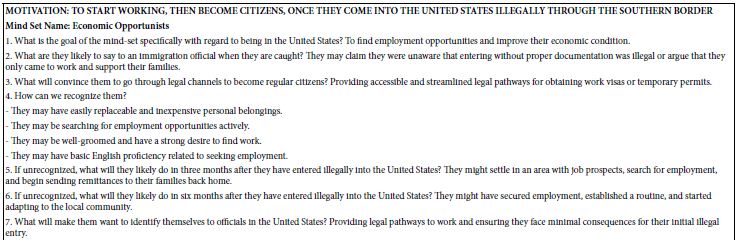

Table 4: Two mind-sets emerging from AI when the motivation is to get jobs and bring in their family living in poverty

Table 5: Three mind-sets emerging from AI when the motivation is to harm the United States with gang warfare
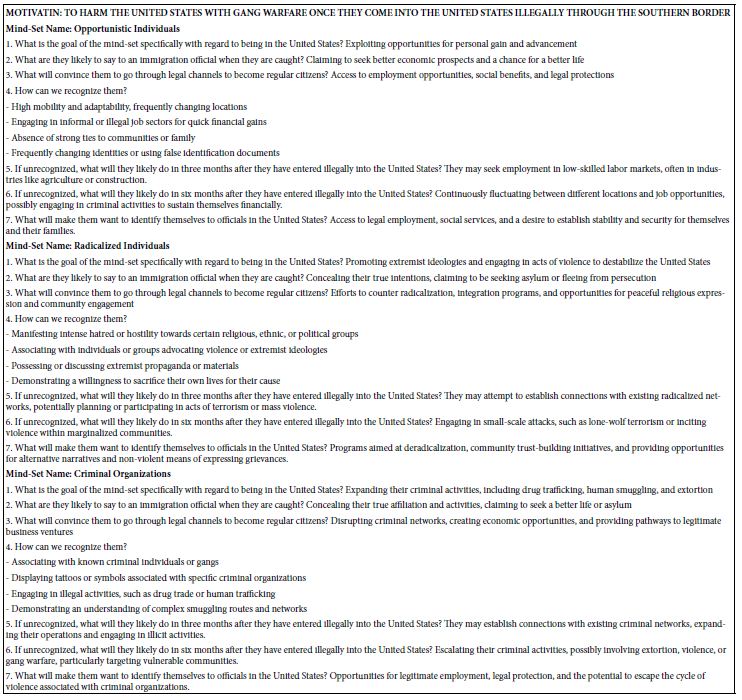
Discussion and Conclusions
The ingoing rationale for this study was to demonstrate that a new opportunity to understand behavior has evolved from the incorporation of AI through Idea Coach into the basic thrust of Mind Genomics. The original objectives of Mind Genomics focused on understanding motivations and decision ‘rules’ for different types of people, with these rules emerging from material taken from the granular, everyday world. The development of AI made it possible to accelerate the process by producing a way to help people ask questions and create answers for that question.
The introduction of AI also made it possible to go into directions not thought of before, or if thought of, then consigned to the world of the theoretical. We are talking here about ‘what if’ questions. What if we could ascribe basic motivations to people, almost making the task which involves synthetic people, rather than real people. This paper shows what can be done by creating synthetic people, simply by telling AI that there are three mind-sets, giving some background, and then systematically varying some aspect of that background. Tables 1-5 show what happens when the user moves from no motivation stated to a variety of different motivations.
Up to now a major focus of AI in law enforcement has been to detect patterns in the transfer of money and other objects, almost the combination of Big Data and the Internet of Things [4-7]. The use of AI to construct synthetic mind-sets for law may be in progress but is not yet mainstream. On the other hand, the use of AI to construct synthetic people for surveys is beginning to become mainstream, at least in the market research community. There is every reason to assume that the use of AI to construct scenarios and synthetic people, as well as synthetic mind-sets, will become mainstream, and perhaps even significant. To the degree that the approach presented here becomes a tool for critical thinking in law and public policy, we may expect to see the approach presented here proliferate and improve thinking as well as public policy.
References
- Moskowitz H, Todri A, Papajorgji P, et al. (2023) Sourcing and vetting ideas for sustainability in the retail supply chain: The Contribution of artificial intelligence coupled with Mind Genomics. International Journal of Food System Dynamics 14: 367-380.
- Gofman A & Moskowitz H (2010) Isomorphic permuted experimental designs and their application in conjoint analysis. Journal of Sensory Studies 25: 127-145.
- Raghunathan TE (2021) Synthetic Data, Annual Review of Statistics and Its Application 8, 129-140.
- Borum R (2020) Scientific and technological advances in law enforcement intelligence analysis. Science Informed Policing 99-121.
- Rademacher T (2020) Artificial intelligence and law enforcement. In: Regulating Artificial Intelligence, (ed, T. Wischmeyer & T, Rademacher), Springer Link 225-254.
- Watney M (2019) Law Enforcement Use of Artificial Intelligence for Domestic Security: Challenges and Risks. In Proceedings of the European Conference of Artificial Intelligence and Robotics (ECIAR), Oxford, UK, November 341-348.
- Yavorsky MA and Mikheeva SV (2022) The Use of Artificial Intelligence Technologies and Big Data in Law Enforcement. In Proceedings of the International Conference Engineering Innovations and Sustainable Development 669-675. Springer International Publishing.